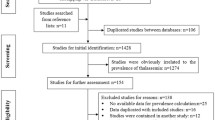Abstract
The spread of thalassemia among prehistoric populations of the Mediterranean basin has been linked to the increased risk to early agriculturalists posed by thePlasmodium falciparum parasite. We here present the earliest case, to our knowledge, of thalassemia diagnosed on the basis of long bone remains. We further discuss the value of this finding for our understanding of the transition from foraging to agriculture.
Similar content being viewed by others
References
Allison A.C., 1955.Aspects of polymorphism in Man. Cold Spring Harbor Symp. Quant. Biol., 20: 239–252.
Angel J.L., 1964.Osteoporosis: thalassemia? Am. J. Phys. Anthropol., 22: 369–374.
Angel J.L., 1969.Paleodemography and evolution. Am. J. Phys. Anthropol., 31: 343–354.
Angel J.L., 1973.Early Neolithic people of Nea Nikomedeia. In: Die Anfange des Neolithikums vom Orient bis Nordeuropa. Bohlau Verlag Koln Wien, pp. 103–112.
Angel J.L., 1975.Paleoecology, paleodemography and health. In: S. Polgar (ed.) Population, Ecology and Social Evolution. Mouton Press, The Hague, pp. 167–190.
Angel J.L., 1978.Porotic hyperostosis in the Eastern Mediterranean.Medical College of Virginia Quarterly, 14(1): 10–16.
Angel J.L., 1984.Health as a crucial factor in the changes from hunting to developed farming in the eastern Mediterranean. In: M.N. Cohen and G.J. Armelogos (eds.) Paleopathology at the Origin of Agriculture. Academic Press, New York, pp. 51–71.
Ascenzi A., 1979.A problem in palaeopathology. The origin of thalassemia in Italy. Virchows Arch. A. Path. Anat. Histol., 384: 121–130.
Ascenzi A &Balistreri P., 1977.Porotic hyperostosis and the problem of origin of thalassemia in Italy. J. Hum. Evol., 6: 595–604.
Caffey I., 1957.Cooley's anemia: A review of the roentgenographic findings in skeletons. Am. J. Roentgenol. 78: 381.
Carlson D.S., Armelagos G.J., &Van Gerven D.P., 1974.Factors influencing the etiology of cribra orbitalia in prehistoric Nubia. J. Hum. Evol. 3: 405–410.
Cook D.C., 1984.Subsistence and health in the Lower Illinois Valley: Osteologic evidence. In: M.N. Cohen and G.J. Armelagos (eds.) Paleopathology at the Origins of Agriculture. Academic Press, New York. pp. 237–269.
Cooley T.B. &Lee P., 1925.A series of cases of splenomegaly in children with anemia and peculiar bone changes. Trans. Amer. Pediat. Soc., 37: 29.
Currarino G. &Erlandson M.E., 1964.Premature fusion of epiphyses in Cooley's anemia. Radiology, 83: 656–664.
El-Najjar M., Ryan D.J., Turner C. &Lozoff B., 1976.The etiology of porotic hyperostosis among the historic and prehistoric Anasazi Indians of Southwestern United States. Am. J. Phys. Anthropol., 44: 477–488.
Exarchou E., Politou C., Vretou E., Pasparakis D., Madessis G. &Caramerou A., 1984.Fractures and epiphyseal deformities in beta-thalassemia. Clin Orthopedics, 189: 229–233.
Gatto, I., 1948.Sulla ereditarieta della malattia di Cooley. Minerva Med., 19 (1): 194–198.
Gatto, I., 1960.Origine della talassemia. Atti VII Congr. Internaz. Ematologia, 3: 413–419.
Gloria-Bottini F., Falsi A.M., Mortera J. &Bottini E., 1980.The relations between G-6-PD deficiency, thalassemia and malaria. Further analysis of data from Sardinia and the Po Valley. Experientia, 36: 541.
Harris H., 1980.Human-Biochemical Genetic. Elsevier/North-Holland Biomedical Press, p. 121.
Hengen O.P., 1971.Cribra orbitalia: Pathogenesis and probable etiology. Homo, 22: 57–75.
Hershkovitz I. &Galili E., 1990.8000 years-old human remains on the sea floor near Atlit, Israel. Hum. Evol., 5: 319–358.
Hershkovitz I., Galili E. & Ring B., 1989.Human skeletons 8000 years under the sea: A Pre-Pottery Neolithic village off the Israeli coast. L'Anthropologie (in press).
Kennedy K.A.R., 1984.Growth, nutrition and pathology in changing paleodemographic settings in South Asia. In: M.N. Cohen and G.J. Armelagos (eds.) Paleopathology at the origins of Agriculture. Academic Press, New York, pp. 169–192.
Lawson J.P., Ablow R.C. &Pearson H.A., 1983.Premature fusion of the proximal humeral epiphyses in thalassemia. Radiology, 140: 239–244.
Maxia C. &Cossu D., 1950.Ricerche anatomiche e radiografiche dei segni del morbo di Cooley nei crani Sardi dal periodo neolitico a quello medievale-moderno. Ann. Ital. Pediatr., 3: 415–416.
Mosely J.E., 1963.The paleopathologic riddle of «symmetrical osteoporosis». Am. J. Roentgenol., 95: 135–142.
Ortner D.J. &Putscher, W.G., 1981.Identification of Pathological Conditions in Human Skeletal Remains. Smithsonian Institution Press, Washington, D.C. pp. 251–263.
Post M., 1988.The Shoulder. 2nd ed. Lea and Faber. pp. 92–93.
Silvestroni E., Bianco I. &Alfieri N., 1952.Sulle origini della microcitemia in Itali e nelle altre regioni della terra. Medicina, 2: 187–216.
Author information
Authors and Affiliations
Rights and permissions
About this article
Cite this article
Hershkovitz, I., Edelson, G. The first identified case of thalassemia?. Hum. Evol. 6, 49–54 (1991). https://doi.org/10.1007/BF02435606
Received:
Accepted:
Issue Date:
DOI: https://doi.org/10.1007/BF02435606




